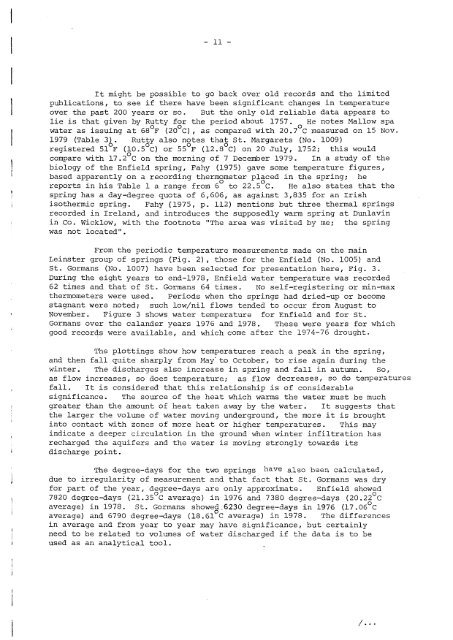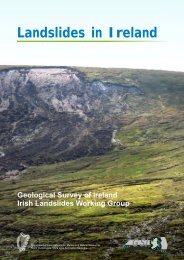Hydrogeothermal Conditions in Ãire - Geological Survey of Ireland
Hydrogeothermal Conditions in Ãire - Geological Survey of Ireland
Hydrogeothermal Conditions in Ãire - Geological Survey of Ireland
You also want an ePaper? Increase the reach of your titles
YUMPU automatically turns print PDFs into web optimized ePapers that Google loves.
- 11 -It might be possible to go back over old records and the limitedpublications, to see if there have been significant changes <strong>in</strong> temperatureover tQe past 200 years or so. But the only old reliable data appears tolie is that given by Rutty for the period about 1757. He notes Mallow spawater as issu<strong>in</strong>g at 68 0 F (20 0 C), as compared with 20.7 0 e measured on 15 Nov.1979 (Table 36. Rutty also notes that st. Margarets (NO. 1009)registered 51 F (lO.SoC) or 5S o F C12.8 0 C) on 20 July, 1752; this wouldcompare with 17.2 0 C on the morn<strong>in</strong>g <strong>of</strong> 7 December 1979. In a study <strong>of</strong> thebiology <strong>of</strong> the Enfield spr<strong>in</strong>g, Fahy (1975) gave some temperature figures,based apparently on a record<strong>in</strong>g thermometer placed <strong>in</strong> the spr<strong>in</strong>g; hereports <strong>in</strong> his Table I a range from 6 0 to 22.5 0 C. He also states that thespr<strong>in</strong>g has a day-degree quota <strong>of</strong> 6,606, as aga<strong>in</strong>st 3,835 for an Irishisothermic spr<strong>in</strong>g. Fahy (1975, p. 112) mentions but three thermal spr<strong>in</strong>gsrecorded <strong>in</strong> <strong>Ireland</strong>, and <strong>in</strong>troduces the supposedly warm spr<strong>in</strong>g at Dunlav<strong>in</strong><strong>in</strong> Co. Wicklow, with the footnote "The area was visited by me; the spr<strong>in</strong>gwas not located".From the periodic temperature measurements made on the ma<strong>in</strong>Le<strong>in</strong>ster group <strong>of</strong> spr<strong>in</strong>gs (Fig. 2), those for the Enfield (NO. 1005) andst. Gormans (No. 1007) have been selected for presentation here, Fig. 3.Dur<strong>in</strong>g the eight years to end-1978, Enfield water temperature was recorded62 times and that <strong>of</strong> St. Gormans 64 times. No self-register<strong>in</strong>g or m<strong>in</strong>-maxthermometers were used. Periods when the spr<strong>in</strong>gs had dried-up or becomestagnant were noted; such low/nil flows tended to occur from August toNovember. Figure 3 shows water temperature for Enfield and for st.Gormans over the calander years 1976 and 1978. These were years for whichgood records were available, and which come after the 1974-76 drought.The plott<strong>in</strong>gs show how temperatures reach a peak <strong>in</strong> the spr<strong>in</strong>g,and then fall quite sharply from May'to October, to rise aga<strong>in</strong> dur<strong>in</strong>g thew<strong>in</strong>ter. The discharges also <strong>in</strong>crease <strong>in</strong> spr<strong>in</strong>g and fall <strong>in</strong> autumn. So,as flow <strong>in</strong>creases, so does temperature; as flow decreases, so do temperaturesfall. It is considered that this relationship is <strong>of</strong> considerablesignificance. The source <strong>of</strong> the heat which warms the water must be muchgreater than the amount <strong>of</strong> heat taken away by the water. It suggests thatthe larger the volume <strong>of</strong> water mov<strong>in</strong>g underground, the more it is brought<strong>in</strong>to contact with zones <strong>of</strong> more heat or higher temperatures. This may<strong>in</strong>dicate a deeper circulation <strong>in</strong> the ground when w<strong>in</strong>ter <strong>in</strong>filtration hasrecharged the aquifers and the water is mov<strong>in</strong>g strongly towards itsdischarge po<strong>in</strong>t.The degree-days for the two spr<strong>in</strong>gs have also been calculated,due to irregularity <strong>of</strong> measurement and that fact that st. Gormans was dryfor part <strong>of</strong> the year, degree-days are only approximate. Enfield showed7820 degree-days (21.3S o C average) <strong>in</strong> 1976 and 7380 degree-days (20.22 0 Caverage) <strong>in</strong> 1978. St. Gormans showed_6230 degree-days <strong>in</strong> 1976 (17.06 0 eaverage) and 6790 degree-days (18.61 0 C average) <strong>in</strong> 1978. The differences<strong>in</strong> average and from year to year may have significance, but certa<strong>in</strong>lyneed to be related to volumes <strong>of</strong> water discharged if the data is to beused as an analytical tool./ ...
















